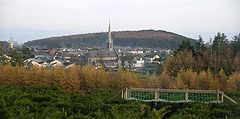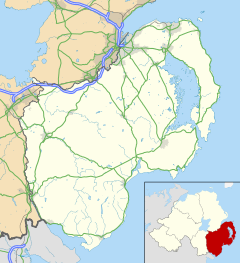Castlewellan (from Irish Caisleán Uidhilín 'Hugelin's Castle') is a small town in County Down, in the south-east of Northern Ireland close to the Irish Sea. It is beside Castlewellan Lake and Slievenaslat mountain, 11 miles (18 km) southwest of Downpatrick. It lies between the Mourne Mountains and Slieve Croob. It had a population of 2,782 people in the 2011 census.[1]
Castlewellan
| |
|---|---|
 Castlewellan village, from the "Peace Maze" | |
Location within County Down | |
| Population | 2,782 (2011 census) |
| District | |
| County | |
| Country | Northern Ireland |
| Sovereign state | United Kingdom |
| Post town | CASTLEWELLAN |
| Postcode district | BT31 |
| Dialling code | 028 |
| UK Parliament | |
| NI Assembly | |

Castlewellan has a wide main street which runs through two main squares lined with chestnut trees. The town was designed by a French architect for the Annesley family. The Annesley family did not always own the land as they bought it from the Maginess family, then owners of what is now Castlewellan Christian Conference Centre and Castlewellan Forest Park. Castlewellan is unique within Ireland due to its tree-lined squares both in the old town (upper square) and new town (lower square) as well as its very wide main street.[citation needed] The old market house in the upper square was built in 1764 and now houses the public library.[2]
History
editEvidence of ancient settlement in the area includes the Drumena Cashel - a small stone-built farmstead enclosure (or cashel) from the Early Christian period. It is 2 miles (3 km) south west of Castlewellan off the A25 road to Rathfriland.[3][4] Also nearby is Legannany Dolmen, approximately 3 miles (4.8 km) to the north near the village of Leitrim, on the slopes of Slieve Croob.[5] Goward Dolmen is a megalithic monument 2 miles (3.2 km) from Hilltown on the road to Castlewellan. The huge granite capstone of this structure has slipped from its original horizontal position.[6]
12 July 1849 saw the Dolly's Brae conflict. Up to 1400 armed Orangemen marched from Rathfriland to Tollymore Park near Castlewellan, County Down. On their homeward journey, shots were fired and police were unable to control the situation. None of the Orangemen were harmed, but it was estimated that about 80 Catholics were killed and homes burnt.[7]
Castlewellan Castle, a Scottish baronial castle of 1856, Castlewellan Lake in what is now Castlewellan Forest Park. The castle is now used as a privately run Christian conference centre, and is not generally open to the public.[citation needed]
According to the Sunday Times Insight Team, the entire village (the population then was given as 819) was bound over to keep the peace for a year in 1953 after disorder at an Orange walk.[8]
The Troubles
editA number of incidents occurred in Castlewellan during the Troubles. For example, in January 1980, three members of the Ulster Defence Regiment were killed in a Provisional Irish Republican Army land mine attack on their mobile patrol near Castlewellan. Those killed included James Cochrane (21, a Catholic), Robert Smyth (18, a Protestant), and Richard Wilson (21, a Protestant).[9]
Castlewellan has historically been an Irish Republican town.[citation needed] In 2016, a large Republican commemoration of the 1916 Rising was held in the town.[10] A march, commemorating the 1981 hunger strikes, was also held there in 2018.[11]
Throughout the course of the Troubles, the area had a significant paramilitary presence, mostly involving Provisional Irish Republican Army (PIRA) activity.[citation needed] In 2009, the Real Irish Republican Army claimed responsibility a car bomb which had been abandoned in the area.[12]
Amenities
editCastlewellan Forest Park and Castlewellan Lake are situated to the northwest of the village. The arboretum in the park was begun in 1740 and contains plants and trees from several different countries, including Spain, Mexico and Wales;[13] the 'Castlewellan Gold' form of Leyland Cypress – originating from a single mutant tree in the arboretum and widely propagated from the 1970s – was selected by the park director, John Keown, being first named Cupressus macrocarpa Keownii, 1963.[14] The Peace Maze was constructed in the park between 2000 and 2001. Until 2007 it was the longest permanent hedge maze in the world.[15]
Schools
editSchools serving the Castlewellan area include:[citation needed]
Transport
editCastlewellan railway station was opened on 24 March 1906 by the Great Northern Railway of Ireland, but closed on 2 May 1955.[19]
Trains used to connect Newcastle and Belfast via Lisburn.
Events
editThe Celtic Fusion International Musical Arts Festival was held annually in the town for a number of years, starting in 2002.[20]
The Soma Festival is an annual festival held in the town since 2013. It is a festival of live music, family, well-being, food and drink.[citation needed]
Sport
editThe local Gaelic Athletic Association club, Castlewellan GAC, is based in the village.[citation needed] Other local sports clubs include the association football (soccer) club, Castlewellan Town FC.[21] Kilmegan Amateur Boxing Club is situated in the outskirts of the town and takes its name from the town's parish name.[citation needed]
Castlewellan lake plays host to the Queen's Regatta, and formerly hosted the annual Irish University Rowing Championships.[citation needed] Castlewellan Forest Park hosted the All British Open Field Archery Championships in May 2011.[citation needed]
Demography
edit2011 census
editCastlewellan is classified as an intermediate settlement by the Northern Ireland Statistics and Research Agency (NISRA) (i.e. with a population between 2,500 and 4,999 people).[22] On the day of the 2011 census (27 March 2011), the usually resident population of Castlewellan was 2,782, accounting for 0.15% of the NI total.[1] Of these:
- 24.84% were under 16 years old and 10.96% were aged 65 and above.
- 48.71% of the population were male and 51.29% were female.
- 90.29% were from a Catholic community background and 6.51% were from a 'Protestant and Other Christian (including Christian related)' community background.
- 54.31% indicated they had an Irish national identity, 29.58% said they had a Northern Irish national identity and 17.69% gave a British national identity (respondents could indicate more than one national identity).
2001 census
editIn the 2001 census, Castlewellan was also classified as an intermediate settlement by the NI Statistics and Research Agency (NISRA)[23] (i.e. with population between 2,250 and 4,500 people). On that census day (29 April 2001), there were 2,392 people living in Castlewellan. Of these:
- 29.8% were aged under 16 and 13.8% were aged 60 and over.
- 49.4% of the population were male and 50.6% were female.
- 92.1% were from a Catholic background and 6.6% were from a Protestant background
- 4.8% of people aged 16–74 were unemployed.[citation needed]
Notable people
edit- Greer Garson (1904-1996), actress
- Percy Jocelyn (1764-1843), Anglican Bishop
- Niamh McGrady (b. 1983), actress
- Eileen O'Higgins, actress
- Séamus Ó Néill (1910-1981), Irish writer
- Joe Toner (1894-1954), soccer player.
See also
editReferences
edit- ^ a b "Census 2011 Population Statistics for Castlewellan Settlement". Northern Ireland Statistics and Research Agency (NISRA). Retrieved 7 June 2021.
- ^ "Castlewellan.org".
- ^ Drumena Cashel, Irish Antiquities, archived from the original on 14 March 2005
- ^ Drumena Stone Fort, Megalithic Ireland
- ^ "Banbridge". Travel Now. Retrieved 11 December 2007.
- ^ "Goward Dolmen in Clonduff parish". Ros Davies' Co. Down, Northern Ireland Genealogy Research Site. Retrieved 11 December 2007.
- ^ "Parades and Marches – Chronology 2: Historical Dates and Events". Conflict Archive on the Internet (CAIN). Retrieved 28 January 2010.
- ^ Ulster (The Sunday Times Insight Team), 1972, p.96
- ^ NI Conflict Archive on the Internet
- ^ "Republicans In Castlewellan Commemorate the 1916 Rising". downnews.co.uk. 5 April 2016. Retrieved 21 June 2024.
- ^ "Sinn Fein hunger strike march in Castlewellan an insult to our loved ones, say families of IRA victims". belfasttelegraph.co.uk. 24 July 2018. Retrieved 21 June 2024.
- ^ Rayment, Sean (25 April 2009). "Dissident republicans preparing to bomb UK". Telegraph (25 April 2009). London. Archived from the original on 29 April 2009. Retrieved 25 January 2010.
- ^ "Forest Service". Archived from the original on 11 February 2006.
- ^ Gerd Krüssmann, Manual of Cultivated Conifers, Portland: Timber Press, 1995, p. 101
- ^ Peace Maze Archived 20 December 2005 at the Wayback Machine
- ^ "St Malachy's Primary School, Castlewellan".
- ^ "St Malachys High School – St Malachys High School Castlewellan". Retrieved 5 July 2024.
- ^ "School Aims". Bunscoil Bheanna Boirche. Archived from the original on 6 May 2014.
- ^ "Castlewellan station" (PDF). Railscot – Irish Railways. Retrieved 16 September 2007.
- ^ "Celtic Fusion International Musical Arts Festival". Irish Music Magazine. Retrieved 5 May 2014.
- ^ "Castlewellan Town FC". castlewellantownfc.com. Archived from the original on 19 April 2010.
- ^ "NI Assembly" (PDF). Key Statistics for Settlements, Census 2011. Retrieved 2 May 2021.
- ^ "NISRA – Northern Ireland Statistics and Research Agency (c) 2015".[not specific enough to verify]
External links
edit- Website of Castlewellan Regeneration Ltd (archived 2009)
- Castlewellan.org - "The Ins, Outs and Whereabouts of Castlewellan"
- Castlewellan Football Club (archived 2010)
